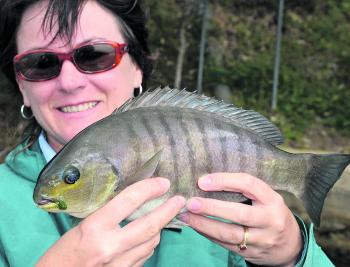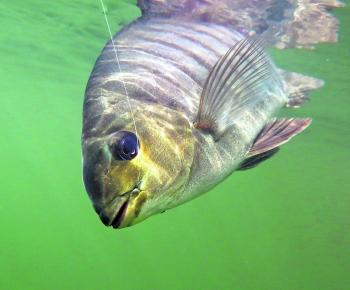Luderick or blackfish are widespread and prolific. They occur in good numbers close to many major population centres. Yet, relatively few anglers specifically target these wily, hard-fighting and tasty saltwater fish, which seems a little odd.
Luderick or blackfish range right around our southeastern seaboard, from about the bottom end of Fraser Island in Queensland to the eastern and northern coasts of Tasmania. Most commonly encountered in tidal estuaries, bays and harbours, they’ll also push upstream into near-fresh water at times, as well as frequenting the wash zones adjacent to ocean headlands, or even further out, around inshore islands.
Luderick commonly run from 400g-1kg+, and very occasionally reach twice that weight. They are handsome, hard-fighting fish that cook up beautifully if properly processed (bled, filleted and skinned within a few hours of capture). However, surprisingly few fishers regularly chase luderick or blackfish, especially in waters outside of NSW. Even in the Premier State, blackfishing is nowadays seen as rather ‘old school’ and seems to have lost favour among the younger generation of sport fishers. To my mind, this is a shame, as they’re truly great fish!
Luderick are classed as ‘omnivores’, and will eat a wide variety of both animal and vegetable matter. A large part of their diet typically consists of various marine algae or weeds, especially the long, filamentous varieties known to anglers simply as “green weed”, as well as the shorter, crinkled stuff that grows in little bunches or rosettes in the inter-tidal zone along ocean rock ledges – commonly referred to as ‘cabbage weed’ or ‘sea lettuce’.
In addition to marine algae, blackfish will happily consume worms, small crustaceans and even tiny fish at times. Perhaps that’s why we occasionally catch them on both hard and soft lures intended for bream, flathead or estuary perch. There are also areas and times of the year that produce excellent bags of blackfish on baits such as squirt worms, bass yabbies (nippers), cunjevoi, bread and even peeled prawn tails. However, to consistently score luderick across the calendar and throughout their range, it’s necessary to offer them their favourite food – weed!
Weed baits are best presented on small (No. 10- No. 6) hooks tied to fine (2–4kg) mono leaders and suspended beneath light floats. Traditional blackfish specialists often use long (3–4m), soft or slow-tapered rods and simple centrepin reels for this task, although spinning reels and light sidecasts will certainly do the job. Floats (whether of the stemmed variety or bobby corks) should be weighted or ballasted so that the softest bite easily pulls them underwater. Baits are usually set to hang in mid-water or deeper, often several metres beneath the surface, and floats may be rigged either fixed to the main line or running freely below a stopper of some sort. There are almost as many ways to rig up for blackfish as there are luderick specialists!
There are plenty of great video clips on YouTube and elsewhere that detail highly effective rigging, baiting and berleying techniques to catch luderick. If you’re interested in exploring this topic further, seek out a few of these clips. The QR code will take you directly to one that I presented a few years ago about catching blackfish from the ocean rocks, but there are also plenty of others on offer.
However, be warned: blackfishing has a way of getting into your blood and dominating your daydreams. These fish offer just the right mix of challenge, willingness and availability, and will quickly become a favourite target with many anglers if given half a chance. They’re certainly well up on my personal list. If you haven’t given the humble luderick a try, you really should!
QR
My advice on catching a few luderick from the ocean rocks.
Reads: 5417
Luderick or blackfish tick all the boxes necessary to qualify as a top notch angling target: they’re attractive, hard-fighting, readily available, good to eat and require just enough specialisation and skill to make the entire process of catching them ext

Once hooked, blackfish or luderick fight hard, all the way to the landing net. Fine leaders and small hooks are the go.

A hooked blackfish doggedly resists capture.

Fish for the future and carefully put the little ones back to do some more growing.




